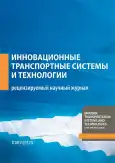Методика определения контактных напряжений под вальцом вибрационного катка
- Авторы: Федосеев Н.А.1, Ермошин Н.А.1, Алексеев С.В.1
-
Учреждения:
- Санкт-Петербургский политехнический университет Петра Великого
- Выпуск: Том 11, № 1 (2025)
- Страницы: 115-133
- Раздел: Оригинальные статьи
- URL: https://bakhtiniada.ru/transj/article/view/289347
- DOI: https://doi.org/10.17816/transsyst676902
- ID: 289347
Цитировать
Полный текст
Аннотация
Цель. Выделение основных факторов для решения контактной задачи и последующее определение контактных напряжений под гладким вальцом катка в режиме вибрации.
Материалы и методы. Основой расчетных зависимостей выбрана теория Герца-Беляева. Так же проведен анализ работ Н.Я. Хархуты, А.В. Захаренко, С.В. Носова, С.В. Савельева и других исследователей. Учитывается инерционная составляющая массы катка и периодический характер воздействия внешней силы на грунт.
Результаты. Выделены основные принципы расчета контактных напряжений. Определен физический смысл коэффициентов, позволяющих осуществить переход от статического уплотнения к вибрационному. По результатам анализа предложен новый подход, учитывающий ранее не рассматриваемые характеристики технологического режима уплотнения. Учтены свойства, присущие дисперсному грунту.
Заключение. Статья посвящена изучению взаимодействия вальца катка с грунтом с точки зрения возникающих контактных напряжений. Предложенная методика характеризует контактные напряжения в зависимости от переменных времени и скорости движения катка. Результат, полученный в ходе вычислительного эксперимента, сопоставлен с фактическими данными.
Полный текст
Открыть статью на сайте журналаОб авторах
Никита Александрович Федосеев
Санкт-Петербургский политехнический университет Петра Великого
Автор, ответственный за переписку.
Email: fedoseev.na@edu.spbstu.ru
ORCID iD: 0000-0001-6104-9674
SPIN-код: 6857-7057
аспирант
Россия, Санкт-ПетербургНиколай Алексеевич Ермошин
Санкт-Петербургский политехнический университет Петра Великого
Email: ermonata@mail.ru
ORCID iD: 0000-0002-0367-5375
SPIN-код: 6694-8297
доктор военных наук, профессор
Россия, Санкт-ПетербургСергей Викторович Алексеев
Санкт-Петербургский политехнический университет Петра Великого
Email: sergeyaleks1966@gmail.com
ORCID iD: 0000-0001-8632-3852
SPIN-код: 6013-0312
кандидат военных наук, доцент
Россия, Санкт-ПетербургСписок литературы
- Kostel’ov MP. Possibility and efficiency of compaction of soils of various types and conditions using vibratory rollers. Catalogue-reference book “Road equipment and technologies”. 2004:10–18. Accessed: 12.12.2024. Available from: https://zaovad.ru/upload/file/2017/01/25/9-dorozhnaya-tehnika-2004-2-s72-82.pdf. (In Russ.)
- Sonin VV. Review of technology for strengthening weak foundations of road embankments. Aktual’nye problemy gumanitarnykh i estestvennykh nauk. 2016;(5):104–107. (In Russ.)
- Kostel’ov MP. Again about the quality and efficiency of compaction of various soils with modern vibratory rollers. Katalog-spravochnik “Dorozhnaya tekhnika i tekhnologiI”. 2008:40–47. Accessed: 12.12.2024. Available from: https://zaovad.ru/upload/file/2017/01/25/11-dorozhnaya-tehnika-2008-1-s40-47.pdf (In Russ.)
- Timofeev DM. Simulation of the design activity diversification of innovative enterprise. Inzhenernyi vestnik dona. 2019;1(52). (In Russ.)
- Tyuremnov IS, Krayushkin AS, Shorokhov DA. Simulation of the design activity diversification of innovative enterprise. Vestnik sibirskogo gosudarstvennogo avtomobil’no-dorozhnogo universiteta. 2022;6(88):828–840. (In Russ.) doi: 10.26518/2071-7296-2022-19-6-828-840
- Saveliev SV, Poteryaev IK, Buriy GG, Beloded AS. Method of justification of operational parameters of vibrating rollers for compaction. Vestnik sibirskogo gosudarstvennogo avtomobil’no-dorozhnogo universiteta. 2017;1(53):27–33. (In Russ.) doi: 10.26518/2071-7296-2017-1(53)-27-33
- Harkhuta NYa. Strength, stability and compaction of roadbed soils. Moscow: Transport; 1975. (In Russ.) Available from: https://search.rsl.ru/ru/record/01006957405
- Harkhuta NYa. Soil Compaction Machines: Theory, Calculation and Design. Moscow; Leningrad: Mashgiz; 1953. (In Russ.)
- Nosov SV. Methodology for improving technologies for compacting road construction materials. Lipeck: Lipeckij gos. tekhnicheskij un-t; 2015. (In Russ.)
- Nosov SV. Mathematical modeling of the process of compaction of road construction materials by a rigid roller of a road roller. Vestnik belgorodskogo gosudarstvennogo tekhnologicheskogo universiteta im. V.G. Shukhova. 2013;4:31–35. (In Russ.) EDN: QCEJOT
- Miheev VV, Savel’ev SV. Modeling the characteristics of deformable soils during their compaction by cylindrical working bodies of rollers. Vestnik sibirskoj gosudarstvennoj avtomobil’no-dorozhnoj akademii. 2016;4(50):29–36. (In Russ.)EDN: WZQPZV
- Zakharenko AV. Theoretical and experimental studies of the processes of compaction of soils and asphalt concrete mixtures by rollers [abstract of the dissertation]. Omsk; 2005. (In Russ.)
- Ignat’ev AA. Determination of rational parameters of vibratory rollers for soil compaction [abstract of the dissertation]. Yaroslavl; 2013. (In Russ.)
- Malich, NG, Blohin VS. Features of compaction between rollers. Gornyj informacionno-analiticheskij byulleten’. 2008;8:345–355. (In Russ.) Available from: https://elibrary.ru/item.asp?id=12363969
- Kondrashov NA. Research and calculation of parameters of a multifunctional roller for compaction of asphalt concrete road surfaces [dissertation]. St. Petersburg; 2016. Accessed: 12.12.2024. Available from: https://dis.spbgasu.ru/file/1783/download?token=Waer_8Lm (In Russ.)
- Bugrov AK. Mekhanika gruntov: schoolbook. St. Petersburg: Izd-vo Politekhnicheskogo un-ta; 2011. (In Russ.)
- Fedoseev NA, Alekseev SV, Shevchenko SM. A review of the theoretical preconditions for soil compaction. Modern transportation systems and technologies. 2024;2(10):200–214. (In Russ.) doi: https://doi.org/10.17816/transsyst627482
Дополнительные файлы











